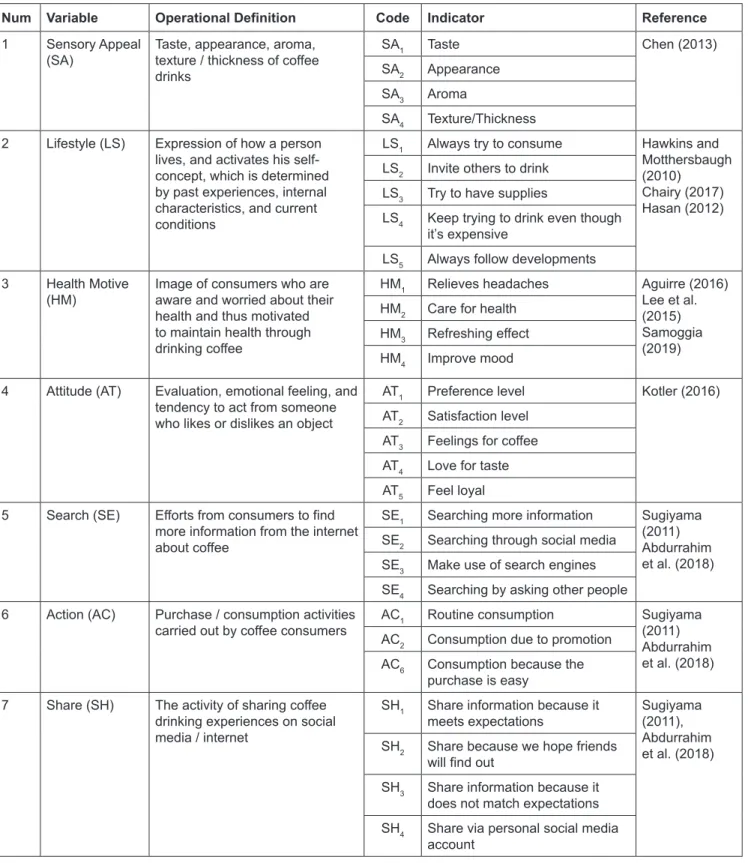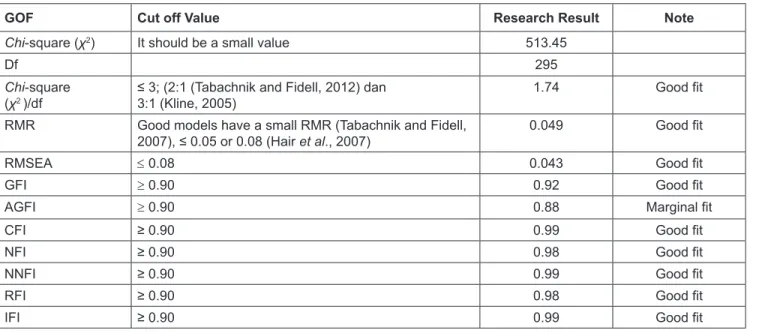Print ISSN: 2288-4637 / Online ISSN 2288-4645 doi:10.13106/jafeb.2021.vol8.no5.0939
Influences of Product Attributes and Lifestyles on Consumer Behavior: A Case Study of Coffee Consumption in Indonesia
Adi Prasetya UTAMA
1, Ujang SUMARWAN
2, Arif Imam SUROSO
3, Mukhamad NAJIB
4Received: January 30, 2021 Revised: April 05, 2021 Accepted: April 15, 2021
Abstract
The purpose of this study was to measure the significance and contribution of sensory appeal, lifestyle, and health motive in determining coffee drink consumption. The theory adopted is the SOR (stimulus-organism-response) theory and the AISAS (attention-interest- search-action-share) model approach. Data was collected online in April–May 2020, and obtained 413 valid respondent data. The data were processed using SEM (Structural Equation Modeling) framework. The results showed that the variable sensory appeal of coffee drinks, lifestyle variables and health motive variables had a significant effect on coffee consumption. Of the 13 hypotheses proposed, nine hypotheses are accepted and four hypotheses are rejected. Sensory appeal has a positive effect on attitude and action of coffee consumption. Lifestyle has a positive effect on attitude, search, and action, whereas health motive has a positive effect on attitude of coffee consumption. Lifestyle variables have the greatest role in determining coffee consumption, followed by health motive variables and sensory appeal of coffee drinks. The SOR theory and the AISAS approach can both be used to analyze coffee drinking behavior.
The research suggests that, to increase coffee consumption, a marketing approach should touch the lifestyle of the community and increase the promotion of the health aspects of coffee drinks.
Keywords: Coffee Consumption, Lifestyle, Health Motive, Sensory Appeal, Product Attributes JEL Classification Code: M310, C520, I120, Z130
in 2018 to 10,109,460 tons, in 2019 to 9,871,800 tons, and in 2020 reaching 9,997,680 tons.
Although globally there has been a significant increase in consumption, the gap in coffee consumption per capita is still relatively high between developed and developing countries.
Coffee consumption per capita in developed countries in 2020 is relatively high, including Norway 10.3kg/year, Switzerland 7.4 kg/year, European Union 5.9 kg/year, USA 4.9 kg/year, Brazil 5.0 kg/year, while consumption of coffee drinks in many developing countries is relatively low, namely, Indonesia only 1.4 kg/year, Vietnam 1.7 kg/
year, the Philippines 1.8 kg/year, Thailand 1.3 kg/year (ICO, 2021). Given this large gap, it is possible to increase coffee consumption in developing countries.
The level of coffee consumption is determined by many factors. Samoggia and Riedel (2018) in their literature review grouped several determinants of coffee consumption, including (1) personal preferences, (2) economic attributes, (3) product attributes, (4) context of consumption, and (5) socio-demographics. However, they also noted that scientific knowledge of the motives and characteristics of coffee consumption is actually
1
First Author and Corresponding Author. Ph.D. Student, School of Business, IPB University, Bogor, Indonesia [Postal Address: Jl. Raya Pajajaran, Babakan, Bogor Tengah, Bogor 16151, Bogor, Indonesia]
Email: prasetya_dmb12@apps.ipb.ac.id; adi_utama@yahoo.com
2
Professor, Department of Family and Consumer Sciences, Faculty of Human Ecology, IPB University, Bogor, Indonesia.
Email: sumarwan@apps.ipb.ac.id
3
Associate Professor, School of Business, IPB University, Bogor, Indonesia. Email: arifimamsuroso@apps.ipb.ac.id
4
Associate Professor, Department of Management, IPB University, Bogor, Indonesia. Email: najib@apps.ipb.ac.id
© Copyright: The Author(s)
This is an Open Access article distributed under the terms of the Creative Commons Attribution Non-Commercial License (https://creativecommons.org/licenses/by-nc/4.0/) which permits unrestricted non-commercial use, distribution, and reproduction in any medium, provided the original work is properly cited.



